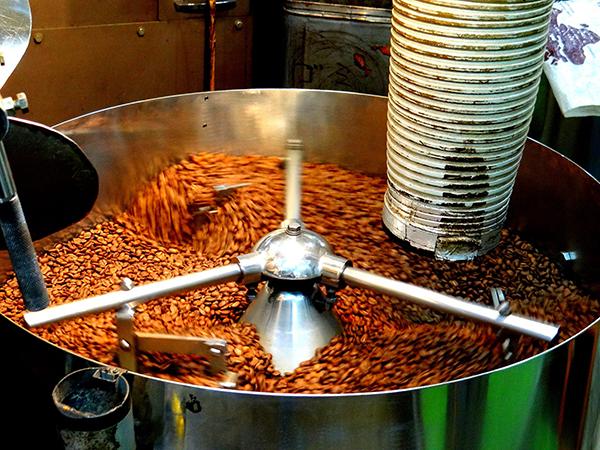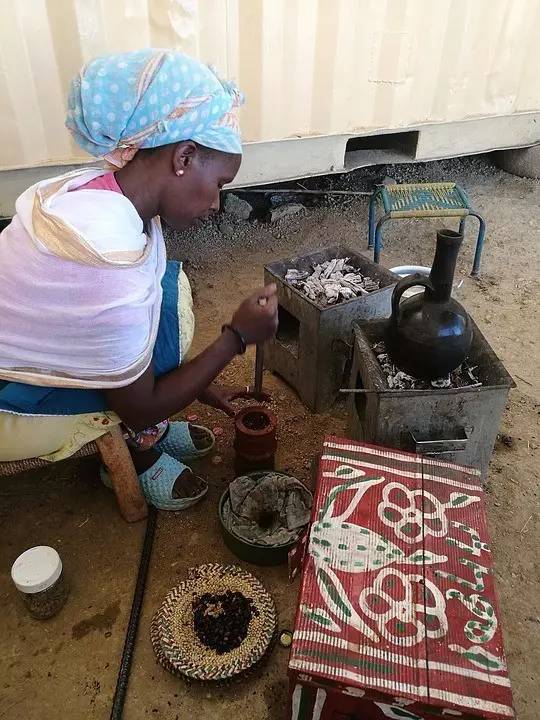Coffee Culture in Japan-- the History of hand-made Coffee and Cafe

Professional barista communication, please pay attention to coffee workshop (Weixin Official Accounts cafe_style)
When I am in Tokyo, I like to stop at different corners of the city and sit at the corner cafes for a while, such as the Nezu Art Museum on the way to Minami-Aoyama, the Obo Cafe on the subway station, and when shopping in Ginza, the Café de L 'ambre in Batchome. Tokyo, where life moves at a rapid pace, takes a break in a cafe and adds a bit of a slow pace to life.
Roast coffee.
Roast coffee.
Kyoto's cafes are also quite charming. After coming out of Ginkakuji Temple, cross a few corners and climb into the mountains for 20 minutes. There is a Maoan hidden in the mountains. It is a "secret shop" that coffee fanatics have heard about. In Shu Guozhi's book "Kyoto for the layman," there is an article entitled "Sitting in a cafe in Kyoto", which mentions cafes in the ancient capital. Some have been in business for decades, while others hide in corners of historical buildings, adding some coffee aroma to the ancient capital.
Is Japanese coffee special? Or is it just the coffee shop?
All are special, especially to the point of becoming the subject of academic research. Merry White, an anthropologist at Boston University in the United States, wrote a book Coffee Life in Japan. Why is Merry White interested in Japanese coffee? She pointed out some surprising facts:
1. Japan is the third largest coffee consumer in the world (after the United States and Germany).
2. Brazil, currently the world's largest coffee producer, is actually the result of cooperation between Japan and Brazil in the 19th century.
3. Coffee was widely drunk in Japan not before Starbucks was introduced, but 100 years ago, when the world's first coffee chain was born.
4.100 Years ago, coffee shops have become an important living space in Japan, promoting the modernization and creation of Japanese culture.
If none of this surprises you, let me cite one more point. The first cafe to open in Japan is also related to Taiwan.
Japan's first coffee shop
Zheng Chenggong, who opposed the Qing Dynasty and restored the Ming Dynasty, had a younger brother in Japan who worked as a translator in Nagasaki for generations. Their family was very important for the development of Chinese education in Japan. In the mid-18th century, Zheng Yongning, then the interpreter of the shogunate, knew that the situation was changing. They knew that not only Chinese, English and French were important foreign languages.
Zheng Yongning has three sons: Zheng Yongbang, Zheng Yongchang and Zheng Yongqing. Zheng Yongbang participated in the signing of the Treaty of Shimonoseki ceding Taiwan; Zheng Yongchang was also responsible for foreign affairs; Zheng Yongqing opened Japan's first coffee shop in Tokyo in 1888.
When Zheng Yongqing was young, he first went to study in the United States, enrolled in Yale University, and later came to London, and once studied French in Paris. Instead of taking over his family's translation business, the young Zheng took another route, transplanting coffee shops to Japan that he had seen in the West.
At that time, Western cafes gathered many intellectuals to discuss and share new knowledge. Zheng Yongqing attempted to create a new cultural space in Japan. He put a lot of books, newspapers and magazines in the "May Tea House" and displayed western novelty. However, the atmosphere at that time was not open, and he was not good at business, so he finally went bankrupt.
The Japanese were exposed to coffee earlier than Zheng Yongqing opened a cafe, but coffee was used as medicine in the past. The earliest record of coffee is in the trade books with the Dutch at the end of the eighteenth century. At first people didn't know how to translate koffie. They found the words "can","kefei","gufei","guxi" and "jiaxi". Finally, the Japanese characters were written as "jia". Later, similar usage was adopted in Chinese.
Although Zheng Yongqing did not succeed, Japanese coffee shops gradually became popular more than ten years after the closure of "Can Tea House". From the late Meiji period to the early Taisho period, that is, the end of the 19th century and the beginning of the 20th century, coffee shops mushroomed in Tokyo, Yokohama, Osaka and Kobe.
Coffee shops were not just places where men gathered. In addition to women serving as waiters, educated women also entered coffee shops with men. There is also a women's section on the second floor of the Old St. Paul Cafe, where the editorial meetings of Japan's first feminist literary magazine, Qingyi, were held frequently in 1911.
Old St. Paul Cafe later opened branches in major cities in Japan, becoming the world's first coffee chain. As a result of the opening of the Japanese market, on the one hand, the price of Brazilian coffee recovered, saving Brazil's coffee industry; on the other hand, Brazilian coffee beans were no longer controlled by Western powers, and Japan also had a stable source of coffee beans.
Hand-brewed coffee.
Hand-brewed coffee.
Before World War II, as the coffee population increased, not only coffee shops, but also coffee options were added to the drinks of the general public, and large-scale coffee companies such as Key Coffee and the internationally renowned Ueshima Coffee Company (UCC) were established in the 1930s.
UCC Coffee was founded in 1933 and has a history of more than 80 years. It has mastered the production chain from the import of raw beans to roasting and processing. It has directly entered the production area to regulate the cultivation, picking process and price management of tree species. UCC also invented instant coffee and canned coffee, affecting the drinking habits of international coffee.
Japan's coffee drinking habit can be said to be infected by the whole people, from vending machines around to supermarkets. Although it is not a national movement, the fact that East Asian island countries are the third largest coffee consumption market in the world is surprising. Out of Tokyo's population of more than eight million, there are more than 80,000 cafes, so many that there are almost every street corner.
stylized cafe
Although instant, instant or canned coffee can be bought in different places, Japanese people don't think it's coffee, it's purely for pick-me-up, just like coffee machines in offices, where caffeine can be easily ordered at the push of a button. Or Starbucks, which is similar to each other, has the same furnishings, no style, and lacks taste.
I used to look for good coffee shops in New York or Paris, local coffee shops with characteristics, decoration, atmosphere and atmosphere are good, the beans themselves are also very good, but still use machines, press a button to solve everything.
In Tokyo or Kyoto, the basic condition of a good coffee shop is hand-brewed coffee. Hand-brewed coffee is not a mechanized and standardized activity. Hand brewed coffee, on the other hand, seeks individualization, specialization, and stylization.
From the beans chosen by the owner to the way they are roasted to brewed, whether siphoned or filtered, a cup of coffee contains more than just work, but also the professionalism and enthusiasm of the owner.
Choosing a coffee shop represents a preference for the owner's style. Some coffee shops seem to have strong beats, others have thick warm notes, and even with the same beans, different years, water quality, and temperature will produce slight differences.
In different corners of Tokyo, there are homogeneous, universal and mechanized Starbucks, as well as coffee and coffee shops with unique styles and personal temperament.
When coffee shops first came to Japan, they were places to spread Western novelties, similar to what Habermas called "the third space," where students and intellectuals discussed and formed a public space. However, in the course of more than 100 years of development, coffee shops have become more diversified in their functions. They are places where office workers settle their moods before entering the company, places where housewives temporarily stay away from housework, places where otaku fantasize (maid coffee), and small libraries for reading comics and magazines.
Cafes, not only sell coffee, but also provide a space outside the home and workplace where people can rest, wait and breathe.
The world's first coffee chain
The world's first coffee chain was not Starbucks in Seattle, but Café Paulista, opened by Ryu Mizuno in 1909. Mizuno is the first generation of Japanese immigrants to Brazil. At that time, Japanese immigrants mainly went to North America to help with the reclamation of the west. The diligence of Japanese immigrants spread to the ears of the Brazilian government, hoping to introduce Japanese immigrants to Brazil for reclamation.
About 10,000 Japanese immigrants arrived in Brazil in the late 19th century, when coffee prices in Brazil plummeted, and Mizuno seized the opportunity of the times to suggest that the Brazilian government sell beans to Japan.
Mizuno received a large number of free coffee beans from the Brazilian government and opened the first "Old Sao Paulo Cafe" in Ginza Batchome. Since coffee beans were quite cheap, coffee was not expensive, attracting many university students and young intellectuals to discuss and stay here.
Hu Chuanan's Life Circus
Important Notice :
前街咖啡 FrontStreet Coffee has moved to new addredd:
FrontStreet Coffee Address: 315,Donghua East Road,GuangZhou
Tel:020 38364473
- Prev

Barista must know the chronicles of coffee! Coffee History Review
How do you create coffee? Why not? Coffee tournaments around the world and a $30 billion export industry, how did we get here? Also, how did the first, second, third and even fourth waves of coffee come about? If you've ever thought about these questions, be prepared. Old Walter will lead you from the 14th century onwards.
- Next

The trend of coffee in mainland China is becoming more and more popular. Taiwan is an important driver.
For the exchange of professional baristas, please follow the coffee workshop (Wechat official account cafe_style) Taiwan has won the top three coffee-related world competitions, including: Wu Zelin, champion of coffee masters of the 2016 World Cup, Lai Yuquan, champion of the 2014 World Cup bean roasting competition, Liu Bangyu, champion of the 2014 World Cup coffee cup test competition, and Wang ce, the third place in the 2016 World Cup coffee brewing competition.
Related
- How did the Salvadoran coffee industry develop in Central America?
- What exactly does the golden cup extraction of coffee mean?
- The Origin of Coffee flower
- [2023 Starbucks World Earth Day] there are more meaningful things besides free Starbucks coffee!
- What kind of coffee is there in Spain? 9 Flavors of Spanish Coffee
- Aromatic African coffee| Kenya's coffee culture and historical production area
- Liberica Coffee Bean knowledge: the characteristics of Liberian Coffee beans of the three original species of Coffee beans
- The origin and formula of Spanish latte introduces the taste characteristics of Bombon coffee in Valencia, Spain.
- How to adjust the solution of over-extracted coffee
- What is the tasting period of coffee beans? What is the period of coffee and beans? How should coffee wake up and raise beans?

